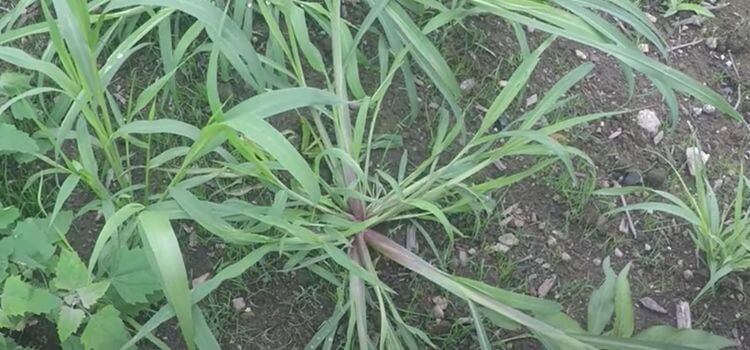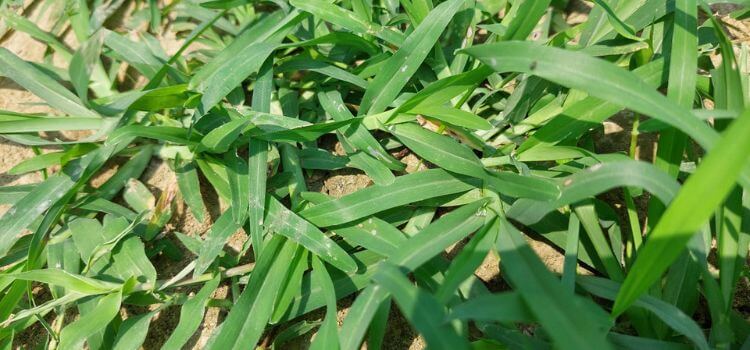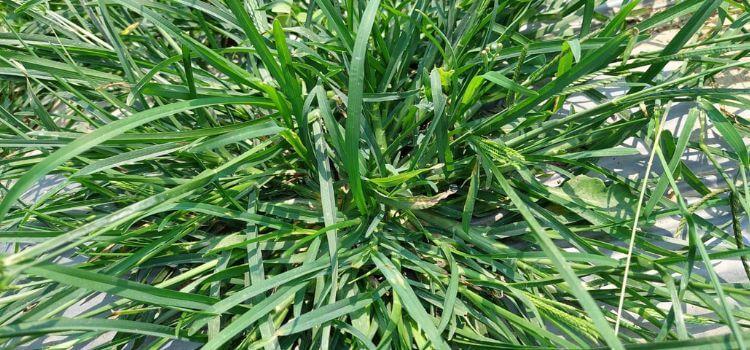As an Amazon Associate, I earn from qualifying purchases.
Crabgrass dies off in the winter, leaving behind clumps of brown, dry grass. Its once green and sprawling foliage turns brittle and lifeless.
Crabgrass, a common lawn invader, is easy to spot during the growing season with its coarse texture and light green colour. Come winter, this pesky weed transforms as the cold weather causes it to die, leaving patches that are unsightly and indicative of where crabgrass once thrived.
Gardeners and homeowners often notice the remnants of crabgrass as they stand out against dormant, healthy grass or in gardens preparing for spring. Managing crabgrass before winter can prevent these dead spots and contribute to a healthier lawn when spring arrives. Timely identification and treatment during the active growth period can save you from the winter aftermath of this aggressive weed.
Appearance Of Crabgrass In Winter
The appearance of crabgrass in winter changes as the seasons transition. This pesky weed, which thrives in the warmer months, transforms. Understanding these changes helps with identification and control.
Colour Of Crabgrass In Winter
During winter, crabgrass doesn’t maintain its summer vibrancy. The green hues fade as the plant enters dormancy. Crabgrass turns a straw-brown colour, blending with the dormant lawn. This colour change is a defense mechanism against the cold.
Shape And Size Of Crabgrass In Winter
- The shape remains consistent with its summer appearance.
- Leaves and stems become brittle and flattened.
- The overall size may shrink slightly due to drying out.
The sprawling nature of crabgrass becomes less pronounced as the plant’s growth halts. The size and shape can help distinguish it from other winter weeds or dormant grasses.

Reasons For Crabgrass Appearance In Winter
Many gardeners are surprised to find crabgrass in their lawns during the colder months. Understanding why this pesky weed persists can help in managing it effectively.
Adaptability Of Crabgrass
Crabgrass thrives in various conditions. This hardy weed adjusts quickly to its surroundings. Its adaptability helps it survive in winter when other plants fail. Below are key points that highlight its robust nature:
- Flexibility in root growth allows crabgrass to find water and nutrients even when scarce.
- Seed dormancy enables crabgrass seeds to remain inactive until conditions improve.
- Quick germination can occur whenever temperatures rise briefly.
Low-Temperature Tolerance Of Crabgrass
Crabgrass is not just a summer weed. It can tolerate low temperatures better than one might expect. Here’s how crabgrass survives the winter chill:
| Feature | Contribution to Winter Survival |
|---|---|
| Seed Coat | Protects seeds from frost and snow |
| Antifreeze Proteins | Prevent ice crystal formation in plant tissues |
| Resilience of Seedlings | Young plants can endure cold snaps |
Despite harsh weather, crabgrass seeds and seedlings have mechanisms to survive, ensuring their presence year-round.
How To Prevent Crabgrass Growth In Winter
As winter approaches, many homeowners dread the sight of crabgrass lingering on their lawns. Crabgrass is stubborn; it can give your lawn an unsightly appearance even in the cold months. But fear not, for with the right strategies, preventing crabgrass growth in winter is achievable.
Pre-emergent Herbicides
Using pre-emergent herbicides is a proactive approach to stopping crabgrass before it starts. These herbicides work by creating a chemical barrier at the soil surface. They should be applied before germination to prevent the weed seeds from sprouting.
- Timing is crucial: Apply in late winter or early spring.
- Read labels carefully: Choose a product suitable for your lawn type.
- Follow instructions: Use the correct amount to avoid harming your grass.
Proper Lawn Maintenance
A healthy lawn is the best defense against crabgrass. Regular maintenance can reduce the chance of weeds taking over.
- Mow high: Taller grass shades the soil, hindering crabgrass growth.
- Water deeply but infrequently: This encourages robust root systems.
- Aerate the soil: This improves nutrient absorption and reduces compaction.
- Fertilize appropriately: Use the right fertilizer at the right time to nourish your lawn.
Effects Of Crabgrass On Lawn
Winter doesn’t give crabgrass a free pass; the battle for a lush lawn continues even in the cold. This pesky weed can leave lasting effects, posing threats to your lawn’s health and beauty.
Disrupts Lawn’s Appearance
Crabgrass turns brown and dies off in winter, leaving behind unsightly patches. These barren spots mar your lawn’s aesthetics, creating a patchy, uneven look. It’s a stark contrast to the green splendor of well-kept turf.
Competes With Desired Grass
- Crabgrass is a fierce competitor, even as winter looms.
- It steals nutrients and water from your desired grasses.
- Your lawn may struggle to recover in spring due to this competition.

Frequently Asked Questions
Crabgrass dies off during the winter, as it cannot survive the cold temperatures. This annual weed seeds in the spring, meaning new plants grow each year.
Tall fescue is often mistaken for crabgrass due to its clumpy growth pattern and similar appearance.
The best time to target and kill crabgrass is in the late spring before it seeds, typically around May. Use pre-emergent herbicides for adequate control.
Crabgrass features light green, coarse blades that spread out in a star-like shape from its center. It increases during warm weather, producing a clumpy appearance. Crabgrass thrives in thin, dry lawns, often forming mats that smother surrounding grasses.
Conclusion
Identifying crabgrass in the winter can be tricky as it often blends with dormant turf. Remember, it turns brown and becomes less noticeable during colder months. Regular lawn maintenance is critical to managing this persistent weed. Stay vigilant and consider seasonal treatments to keep your lawn healthy and crabgrass-free year-round.

